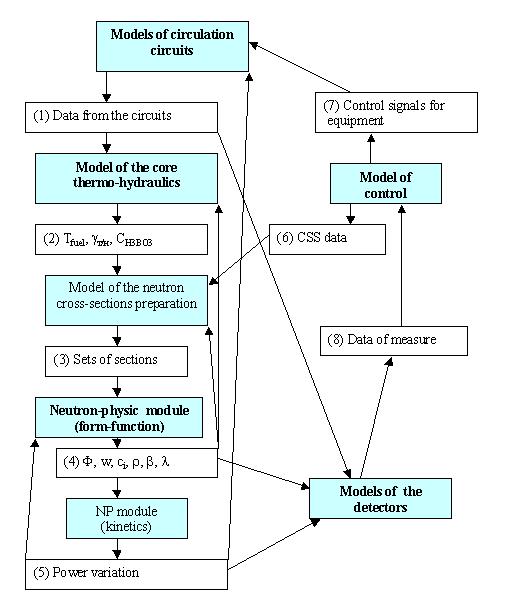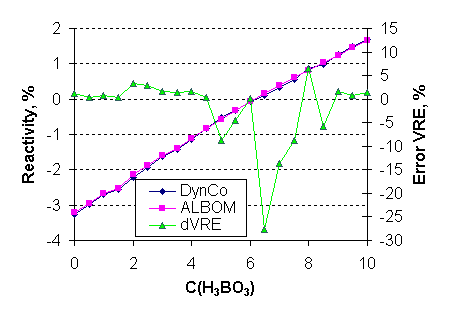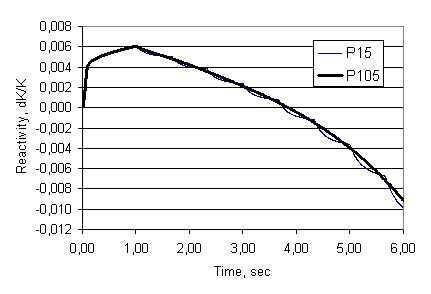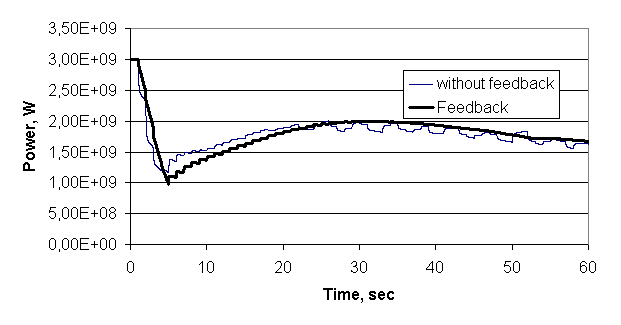|
|
Dynco
Neutronics model of the core for the analytical simulators
Nowadays 3D calculation of the core is a necessary part of the modern simulator systems. The mathematical models are intended to provide the simulator with information on all state changes of the object under simulation as soon as possible and with maximal validity. DynCo code simulates one of the more important units of NPP – the reactor core.
Assignment of the code
DynCo code is intended for complex neutron-physic and thermal hydraulic dynamic calculation of the reactor core in 3D hex-Z geometry.
In designing the main criteria are to provide the maximal complete presentation of the processes in the core and calculation of them with maximal accuracy under computer simulation in real time mode.
Besides the mathematical model, attention is paid also to development of the convenient means of the initial data specification and analyzing the calculation results.
The code carries out simulation of the following processes and contains the modules:
v Spatial neutronics model
Ø 3D diffusion model (hex-Z geometry)
Ø Point kinetic model with spatial coefficients
Ø Poisoning 3D distribution (stationary and dynamic)
Ø Residual power emission
Ø Burning-out
Ø CPS
Ø Boric control
Ø System of detectors (NFMS)
Ø Reactivity meter
Ø Power maintenance automatic system
v Quasi-3D stationary thermal hydraulic model
Ø Transient model of heat transfer for fuel
v System of the constants preparation
| 
Fig. 1. Map of VVER-440 reactor core
|
Structure diagram of DynCo code

Theoretical basis of neutronics calculation
The core code consists of the module of diffusion equation solution.
 , ,
| where |  | fission neutron source. |
The equation is solved by method of incomplete factorization at 9-points pattern. The quasi-static approximation with the variables separation is used.
 * *  , ,
| where | P(t) - fast changing amplitude factor,
y(r,t) - weakly time-dependent group form-function. |
This methods lets to use 2 different time meshes:
- “fine” mesh to calculate kinetics;
- “coarse” mesh to calculate relatively slow processes.
Thus, to calculate the form-function it is obtained:
Statistic part is connected to the model of the neutron kinetics basing on the Gear algorithm.
 Besides that it is possible to calculate reactivity directly through K-effective.
Besides that it is possible to calculate reactivity directly through K-effective.
Calculation of the neutronic constants The group constants consist from the followings:
- diffusion coefficients Dr and Dz that differ in the different directions;
- cross-section of removal from group SCFD;
- cross-section of multiplication nSf;
- cross-section of inter-group transfer Ssj-g.
There is no restriction of the groups number but practically 2 and 4 group calculation is made.
The constants are prepared basing on the preliminary calculated library with the following variable parameters:
- material number (fuel assembly without control rods and with introduced control rods are considered as the different materials);
- average temperature of the fuel composition;
- average density of coolant;
- burn-up of the fuel;
- boric acid concentration (for VVER reactors).
There are the additional corrections for poisoning of the main nuclides (Xe and Sm) that are calculated basing on the solution of differential equations for concentration of the suitable nuclides at every point of calculating mesh.
Accuracy of simulation
Verification of the models has been done by comparison of the calculation results by DynCo code with calculation by the exploiting programs and precise calculation by MCNP code (Monte-Carlo method).
Error of Êeff calculation is:
-0.3% with 7 points at FA (Êeff=1.002344);
-1% with 1 point at FA (Êeff=1.009745).
Change of the differential parameters is smooth.

Fig. 3. Calculation of empty effect of VVER-1000 reactor reactivity

Fig. 4. Neutron flux in the reactor cross-section as a function of CPS group insertion deepness
Calculation error of the neutron fluxes is less than 3% in the central FA and less than 7% in the periphery FA.
Simulation of dynamic is made by calculation of international benchmark AER-1. It means simulation of “shooting” out of the core of one CPS rod followed by emergency protection operation.
Values of the neutron-physic constants for FA of different enrichment and CPS rods are specified in advance.
Calculations with different height division of the core are demonstrated: 15 and 105 calculation points. As simulation of CPS RB is done with neutron-physic constants, the calculation mesh spacing is of great importance.

Fig. 5. Change of reactivity in calculation of benchmark ÀÅR-1

Fig. 6. Change of neutron power in calculation of benchmark ÀÅR-1.
As the scheme of the dynamic calculation is explicit, it is necessary to introduce of additional stabilization.
Such stabilization is introduction of power reactivity coefficient into parameter of the kinetic equation. At the small time step reactivity is corrected taking into account the changes of reactor integral power.
This approach does not influence on simulation of the stable modes. However, significantly larger interval between re-calculations of the form-function is admissible.
Calculation of accelerated mode of VVER-1000 reactor unit discharge
In the mode of the unit accelerated discharge one group of control rods is thrown down into reactor core and other group is moving down with work speed.
Fig. 7. Change of VVER-1000 reactor power in the mode with additional correction of reactivity (feedback)
and without of it (including the fine time mesh)
Influence of the 3D fields re-calculation frequency on the transition process
The form-function re-calculating interval of 0.01 sec and 1 sec is used in calculation of the accelerated mode of the unit discharge. At the same time the process of gradual cooling of the fuel rods is simulated additionally. This process reduced the positive reactivity emission caused by Doppler effect.
The transition process character does not depend on frequency of 3D fields re-calculation, the parameters of the balanced state are also identical but value of power variance is correspondingly 22% and 30%.
DynCo code is also the basis for additional models.
The simulation is based on the solution of differential equations for the suitable nuclides concentration and their contribution into the detector activation current (ia), and the current resulting from Compton effect (ik).
Basing on the reverse solution of equations it is possible to adjust the scheme of converter what significantly reduces inertia of the Neutron Emission Detector.
Fig. 9. Change of neutron flux at the place of NED location,
detector current when flux changes and output of NED inertia corrector
|